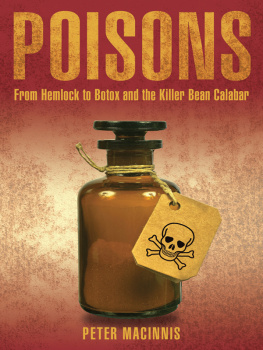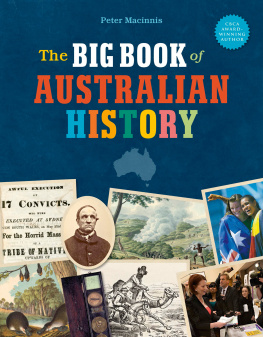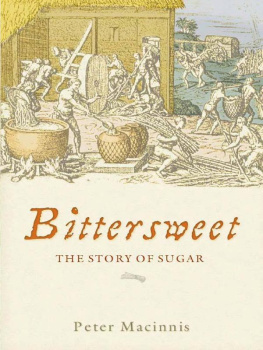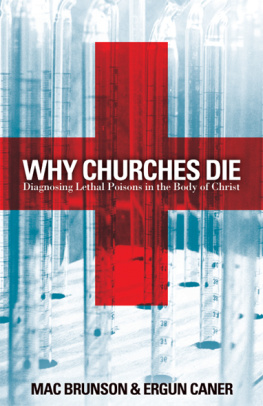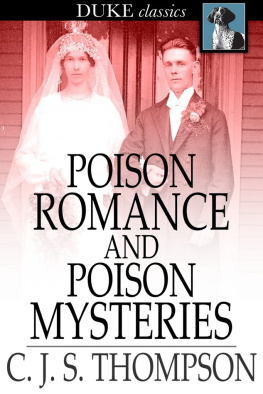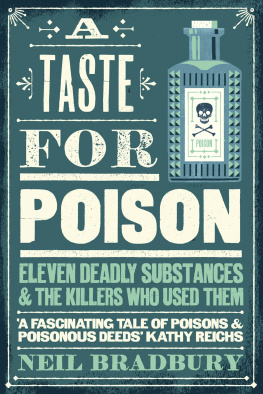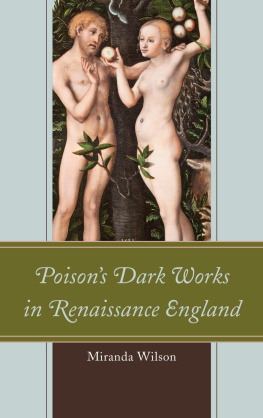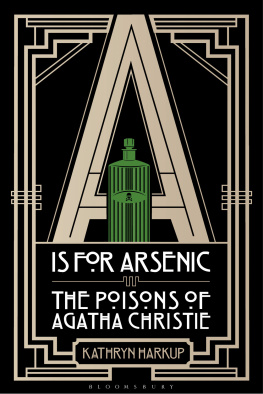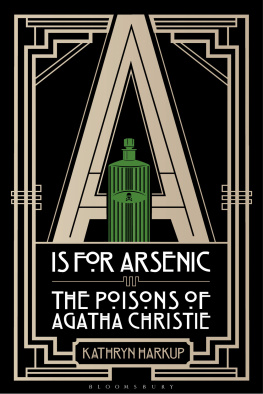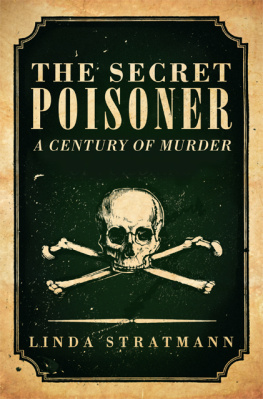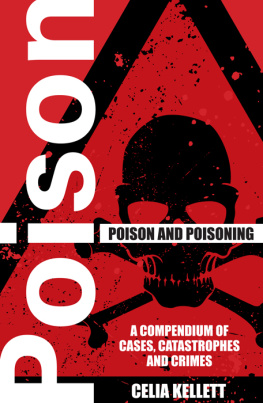POISONS
Also by Peter Macinnis
Bittersweet: The Story of Sugar
Rockets: Sulfur, Sputnik, and Scramjets
POISONS
From Hemlock to Botox and the Killer Bean of Calabar
PETER MACINNIS

Arcade Publishing New York
Copyright 2004, 2011 by Peter Macinnis
All Rights Reserved. No part of this book may be reproduced in any manner without the express written consent of the publisher, except in the case of brief excerpts in critical reviews or articles.
All inquiries should be addressed to Arcade Publishing, 307 West 36th Street, 11th Floor, New York, NY 10018
Arcade Publishing books may be purchased in bulk at special discounts for sales promotion, corporate gifts, fund-raising, or educational purposes. Special editions can also be created to specifications. For details, contact the Special Sales Department, Arcade Publishing, 307 West 36th Street, 11th Floor, New York, NY 10018 or info@skyhorsepublishing.com.
Arcade Publishing is a registered trademark of Skyhorse Publishing, Inc., a Delaware corporation.
Visit our website at www.arcadepub.com.
10 9 8 7 6 5 4 3 2 1
Library of Congress Cataloging-in-Publication Data
Macinnis, Peter.
Poisons : from Hemlock to botox and the killer bean Calabar / Peter
Macinnis.
p. cm.
Originally published: 2005.
Includes bibliographical references and index.
ISBN 978-1-61145-014-9 (alk. paper)
1. Poisons--Popular works.
I. Title.
RA1213.M33 2011
615.9--dc22
2011002434
Printed in the United States of America
CONTENTS
Banks, Joseph (Sir) James Cooks botanist on the cruise of the Endeavour around the Pacific and up the east coast of Australia.
Bassawur Singh In the mid-nineteenth century, drugged his victims with datura seeds and robbed them, until he poisoned himself by accident and robbed no more.
Bocarm, Count de Poisoned his brother-in-law with nicotine and was executed in 1849. His wife was acquitted.
Bonaparte, Napoleon Corsican-born French soldier, general, consul, emperor, and possible poison victim at his death in 1821.
Cadwalader, Thomas In 1745, identified lead contamination of rum as a cause of stomach gripes.
Claudius, Tiberius Claudius Nero Roman emperor who was poisoned by his wife, Agrippina, in AD 54. His son Britannicus was poisoned by Nero in AD 55.
Cleopatra Queen of Egypt who died, reputedly of selfinflicted snakebite, in 30 BC.
Crippen, Dr. Hawley Harvey Poisoned his wife with hyoscine and fled with his lover, Ethel Le Neve, but was captured thanks to the radio telegraph. He was hanged in 1910.
Cromwell, Oliver Roundhead leader who refused to take quinine, not because it was poisonous but because Jesuits had brought it to Europe. He died of malaria in 1658.
Crookes, William (Sir) Discovered thallium in 1861, and later used assorted poisons to fight the British cattle plague.
de la Pommerais, Couty Poisoned his mistress with digitalis for a life insurance policy, and went to the guillotine in 1864.
Defoe, Daniel Author of Robinson Crusoe, he described the use of various poisons in medicine.
Dioscorides, Pedanius A botanist and knowledgeable herbalist who served in Neros armies and died in AD 90.
Domitian, Titus Flavius Domitianus Roman emperor who poisoned his niece while trying to abort their child.
Elisha Old Testament prophet who knew a bit about preventing poisoning. He flourished around 850 BC.
Galba, Servius Sulpicius Made emperor of Rome in AD 68 and assassinated in AD 69, executed Locusta and earlier distinguished himself by crucifying a Roman citizen who had murdered by poison.
Gnaeus Domitius Great-great-great-grandfather of the later Roman emperor Nero. He tried to commit suicide by poison but reneged, in 80 BC.
Goldberger, Joseph By rigorous testing, showed in 1914 that pellagra is a deficiency disease.
Harley, John In 1867, tested hemlock on himself to establish its symptoms, and later recommended it as a treatment for hyperactive children.
Herodotus, of Halicarnassus The first historian, who tended to repeat all that he heard. He died in about 425 BC.
Hippocrates, of Chios The part-legendary traditional founder of medical science. He died around 377 BC.
Holmes, Oliver Wendell American medical writer and physician who died in 1894; father of jurist of same name.
Humbug Billy William Hardaker, a Bradford candy seller whose wares had been accidentally filled with arsenious trioxide, killing 20. He wasnt even charged.
Leichhardt, Ludwig Australian explorer and adventurous taster who disappeared mysteriously in the 1840s. Did he taste the wrong thing, or did a flood get him?
Lister, Joseph English surgeon who first practiced antiseptic medicine, using poison against germs in about 1865.
Locusta A native of Gaul who sold poisons in Rome, and was eventually executed by Emperor Galba.
Louis XIV French king who was almost poisoned by his doctors as a young man and died in 1715 at the age of 77, having ruled over the most poison-ridden court in Europe.
Luce, Clare Boothe Wife of media magnate Henry Luce, writer, U.S. ambassador to Italy, and accidental poison victim, thanks to flaking arsenical paint.
Marsh, James Infuriated by the acquittal of a guilty party, developed the exquisitely sensitive Marsh test for arsenic in corpses.
Maybrick, Florence Convicted in 1889 of murdering her husband, James, with arsenic, she was released in 1904.
Mithridates King of Pontus who, according to legend, took poison in small doses to make himself immune to poisons. He died in 63 BC.
Moore, J(oseph) Earle Medical practitioner and writer on syphilis, who died in 1957.
Muro y Fernandez-Cavada, Dr. Showed that a Spanish poisoning case, attributed to contaminated oil, may have had another cause.
Ovid, Publius Ovidius Naso Roman poet who was a bit of a gossip, and who at one stage was banished to Pontus before dying in AD 17.
Palmer, William The Rugely murderer, who may have killed several people or none with strychnine. He was hanged in 1854.
Pliny (the Elder), Gaius Plinius Secundus Roman writer, scholar, and fleet commander who was asphyxiated by poison gases from Mount Vesuvius in AD 79.
Portinari, Candido Brazilian painter who died in 1962, poisoned by his pigments.
Pritchard, Edward Poisoned his wife, and probably his mother-in-law, with antimony and was hanged in 1865.
Roose, Richard Attempted to kill a bishop with arsenical porridge and was boiled to death in 1531.
Scheele, Carl Discovered prussic acid, and was killed by it four years later in 1786.
Seddon, Frederick Poisoned his lodger, Eliza Barrow, after selling her an annuity. He was hanged in 1912.
Sherman, Mary Acquitted at the Old Bailey in London in 1726 of an arsenic murder. She may have been saved by the primitive tests available.
Shipman, Harold Medical poisoner who committed suicide in 2004, and who may have killed over 200 elderly patients with lethal doses of morphine.
Smith, Madeleine Acquitted on a Not Proven verdict of the murder of her lover by arsenic in 1857.
Socrates Greek philosopher who was condemned to death by taking hemlock in 399 BC.
Suetonius, Gaius Suetonius Tranquillus Roman historian who told a lot of how it really was in the courts of the Roman emperors. He died in AD 160.
Next page
